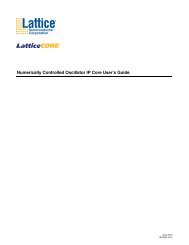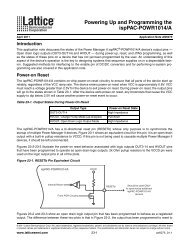DS1036 - Platform Manager Data Sheet - Lattice Semiconductor
DS1036 - Platform Manager Data Sheet - Lattice Semiconductor
DS1036 - Platform Manager Data Sheet - Lattice Semiconductor
You also want an ePaper? Increase the reach of your titles
YUMPU automatically turns print PDFs into web optimized ePapers that Google loves.
CPLD Block<br />
39<br />
<strong>Platform</strong> <strong>Manager</strong> <strong>Data</strong> <strong>Sheet</strong><br />
Figure 22 shows the <strong>Platform</strong> <strong>Manager</strong> power management CPLD architecture, which is derived from the <strong>Lattice</strong><br />
ispMACH ® 4000 CPLD. The power management CPLD architecture allows the flexibility in designing various state<br />
machines and control functions used for power supply management. The AND array has 83 inputs and generates<br />
243 product terms. These 243 product terms are divided into three groups of 81 for each of the generic logic<br />
blocks, GLB1, GLB2, and GLB3. Each GLB is made up of 16 macrocells. In total, there are 48 macrocells in the<br />
<strong>Platform</strong> <strong>Manager</strong> device. The output signals of the <strong>Platform</strong> <strong>Manager</strong> device are derived from GLBs as shown in<br />
Figure 22. Additionally, GLB3 generates the timer control.<br />
Figure 22. <strong>Platform</strong> <strong>Manager</strong> CPLD Architecture<br />
Global Reset<br />
(Resetb pin)<br />
AGOOD<br />
IN[1:4]<br />
6<br />
VMON[1-12]<br />
24<br />
4<br />
Timer1<br />
Timer2<br />
Timer3<br />
Timer4<br />
MCLK<br />
Input<br />
Register<br />
Input<br />
Register<br />
Output<br />
Feedback<br />
48<br />
Timer Clock<br />
IRP<br />
AND Array<br />
83 Inputs<br />
243 PT<br />
14<br />
81<br />
81<br />
81<br />
CPLD Clock<br />
GLB1<br />
Generic Logic Block<br />
16 Macrocell<br />
81 PT<br />
GLB2<br />
Generic Logic Block<br />
16 Macrocell<br />
81 PT<br />
GLB3<br />
Generic Logic Block<br />
16 Macrocell<br />
81 PT<br />
HVOUT[1..4],<br />
OUT[5..8]<br />
OUT[9..12] (ftBGA package)<br />
OUT[9..14] (TQFP package)<br />
OUT[13..16] (ftBGA package)<br />
OUT[15..16] (TQFP package)<br />
Macrocell Architecture<br />
The macrocell shown in Figure 23 is the heart of the CPLD. The basic macrocell has five product terms that feed<br />
the OR gate and the flip-flop. The flip-flop in each macrocell is independently configured. It can be programmed to<br />
function as a D-Type or T-Type flip-flop. Combinatorial functions are realized by bypassing the flip-flop. The polarity<br />
control and XOR gates provide additional flexibility for logic synthesis. The flip-flop’s clock is driven from the common<br />
CPLD clock that is generated by dividing the 8 MHz master clock (MCLK) by 32. The macrocell also supports<br />
asynchronous reset and preset functions, derived from either product terms, the global reset input, or the power-on<br />
reset signal. The resources within the macrocells share routing and contain a product term allocation array. The<br />
product term allocation array greatly expands the CPLD’s ability to implement complex logical functions by allowing<br />
logic to be shared between adjacent blocks and distributing the product terms to allow for wider decode functions.<br />
All the digital inputs are registered by MCLK and the VMON comparator outputs are registered by the CPLD Clock<br />
to synchronize them to the CPLD logic.









